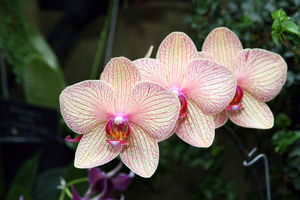Member Plants
Upcoming Global Events

24th World Orchid Conference, Germany
There are currently no photos of plants of
Diglyphosa macrophylla
for sale by members of ORCHIDS.ORG.
Below are other recent plants for sale:
Log in to Add a Comment

Author is Ken Slump, posted almost 5 years ago
A 12-Step Plan for Becoming a Successful Orchid Grower
IF YOU ARE NEW TO THE ORCHID hobby and perhaps feel you are not enjoying the success with your plants that you had hoped for, read throug...
Read More

Author is Roy Tokunaga, posted over 5 years ago
We take water for granted. It falls out of the sky. It flows from the faucet. Oahu city water is considered good for growing Orchids. We use it without thought or concern.
If you study orch...
Read More
Do you have a plant for sale or trade
which you cannot ship or do not want to bother shippping?
No problem.
Click here to make a local-only offer.
It's a free service to our members.
Orchid Species: Diglyphosa macrophylla
Kew currently accepted name is Diglyphosa latifolia
Diglyphosa macrophylla is an orchid species identified by (King & Pantl.) King & Pantl. in 1907. Culture information and photos for this orchid are commonly detailed under the currently accepted name of Diglyphosa latifolia.
Genus
Diglyphosa (Dig.)
Grex
macrophylla
Parents
Species
Author
(King & Pantl.) King & Pantl.
Year
1907
ORIGIN: Found in Yunnan Province China as well as Nepal to Malaysia, Sumatra, Java, Sulawesi, the Philippines and New Guinea in dark spots in forests with lots of rich soil with humus at elevations around 1100 to 1900 meters.
DESCRIPTION: Medium sized, warm growing terrestrial with a creeping rhizome carrying a tall cylindrical pseudobulb with a single, apical, plicate, oval, obtuse leaf which gradually narrows into a 8 [20 cm] long, purple stalked, petiole that blooms in the spring on a basal, 8 [20 cm] long, densely many flowered inflorescence enveloped basally with several, tubular to acuminate bracts and dark purple, narrow, reflexed, floral bracts that come over the ovary and holding the Bulbophyllum-like, foul smelling [chicken feces] flowers towards the apice.
FLOWER SIZE: 0.6 inches [1.5 cm] -- information provided by Jay Pfahl, author of the Internet Orchid Species Encyclopedia (IOSPE).
DESCRIPTION: Medium sized, warm growing terrestrial with a creeping rhizome carrying a tall cylindrical pseudobulb with a single, apical, plicate, oval, obtuse leaf which gradually narrows into a 8 [20 cm] long, purple stalked, petiole that blooms in the spring on a basal, 8 [20 cm] long, densely many flowered inflorescence enveloped basally with several, tubular to acuminate bracts and dark purple, narrow, reflexed, floral bracts that come over the ovary and holding the Bulbophyllum-like, foul smelling [chicken feces] flowers towards the apice.
FLOWER SIZE: 0.6 inches [1.5 cm] -- information provided by Jay Pfahl, author of the Internet Orchid Species Encyclopedia (IOSPE).
Other Names
| Genus Name | Genus | Grex Name | Year | Author | |
|---|---|---|---|---|---|
| Add+ | Diglyphosa | Dig | latifolia | 1825 | Blume |
| Add+ | Chrysoglossum | Cgm | latifolium | 1882 | (Blume) Benth. ex Hemsl. |
| Add+ | Chrysoglossum | Cgm | macrophyllum | 1895 | King & Pantl. |
Featured Site Articles
Read Latest Articles
Beginners Start Here

Water: The Most Important Nutrient
New Topics
- David George asked question Odom's Fascination - an unusual orchid in category General Discussion
- Carol Holdren asked question Grow Tent in the Garage in category General Discussion
- David George asked question rlc Caotan Beauty found at Home Depot in category Cattleya Alliance
- Kristin Dorris asked question Odontocidium Orchid fungus? in category General Discussion
- Maria Fernandez asked question Wild. Lisa Devos in category Dendrobiums
New Comments
- Carol Holdren commented on topic "rlc Caotan Beauty found at Home Depot " by David George
- Carol Holdren commented on topic "Odom's Fascination - an unusual orchid" by David George
- Dr. Florian Wolf commented on topic "Wild. Lisa Devos" by Maria Fernandez
- Michael Valcarcel commented on member plant Rlc. Chief Takanaka by Walceli Muniz Valverde
- Michael Valcarcel commented on member plant Rlc. Montana Spirit by Michael Valcarcel
- Michael Valcarcel commented on member plant Ctt. Blazing Sun by Michael Valcarcel
- Michael Valcarcel commented on member plant Bc. Spotted Clown by Michael Valcarcel
- Maria Skrypnyk commented on member plant Yamadara Redland Sunset by Maria Skrypnyk
- André Pessina commented on topic "Odontocidium Orchid fungus?" by Kristin Dorris
- Linda Hartman commented on topic "Image of a plant please" by Leshya Perkins
- Paul Reavis commented on orchid Milt. Kismet
- Christiaan Viljoen commented on member plant Psh. fragrans by Christiaan Viljoen
- Christiaan Viljoen commented on member plant Z. maculatum by Christiaan Viljoen
- Christiaan Viljoen commented on member plant C. Gaskell-Pumila 'Azure Star' by Christiaan Viljoen
- Robert H. Findlay commented on member plant Rlc. Joy Sokabe var. Volcano Queen by Sally K
- James Lunsford commented on member plant Lc. Sagarik Wax 'African Beauty AMO/AOS x Blc. Cherry Suisse'Kauai' HCC/AOS var. Cattlyea 'Hybrid ' by James Lunsford
- John Varigos commented on orchid Bulb. schwarzii
- Linda Hartman commented on topic "Issue with Blc. Ben O'Neil "Jubilee" by Glenda Ratliff
- Henry Shaw commented on member plant Ons. Catatante 'Los Roble' by Henry Shaw
- Mary Lane commented on member plant Den. Tianmu Canary by Terre Moore



